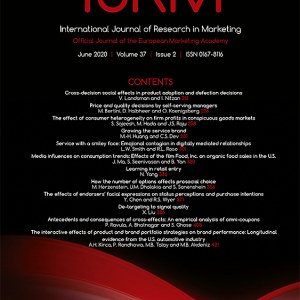
Guyt, J. and Gijsbrechts, E. (2018). On consumer choice patterns and the net impact of feature promotions International Journal of Research in Marketing, 35(3):490--508.
-
Affiliated author
-
Publication year2018
-
JournalInternational Journal of Research in Marketing
Even in the digital age, feature promotions continue to receive significant investments from CPG manufacturers and retailers. Whether this is money well spent depends on consumers' (heterogeneous) tendency to switch brands or stores in response to features. This study proposes a {\textquoteleft}Mixed-pattern Random-effects Nested Logit{\textquoteright} (MRNL) model to analyse the effect of feature promotions in a multi-retailer multi-brand setting. Across 16 different CPG categories, our results reveal that in all cases a mixture of choice patterns prevails: about half of households exhibit a brand focus (i.e. rather substitute between stores offering that brand), the remaining half show evidence of a store focus (i.e. rather substitute brand offers within a visited store). We find that the size of the promotion lift and its underlying sources differ substantially between patterns. Brand-focused consumers are generally more responsive to feature ads than store-focused consumers – especially in low-concentration categories; while they imply much stronger cannibalization for the manufacturer, and much weaker cannibalization for the retailer. It follows that retailers reap much higher benefits in the brand-focused segment, while manufacturers may not prefer that segment in terms of net gains and must be wary of subsidizing those consumers. We identify household and category characteristics that underlie the choice patterns and offer opportunities for targeting.